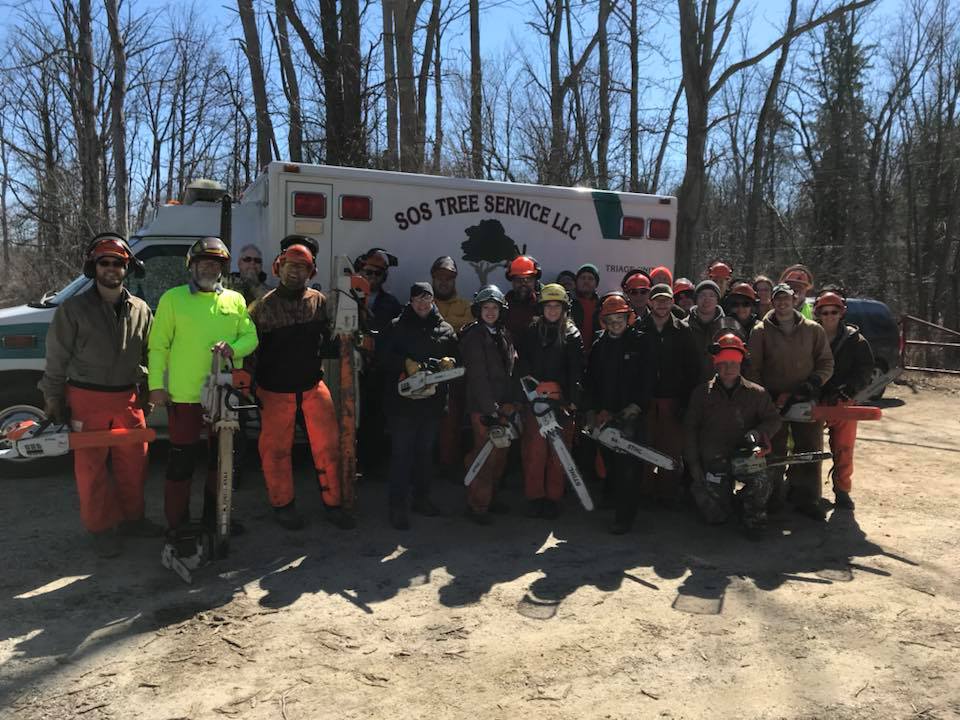
On the Ground: Creating Safer Sawyers
For the fourth consecutive year, MUCC hosted a Chainsaw Safety Training course provided to members, volunteers with OTG, and the general public. In previous years, Chuck Oslund of Bay College has taught his safety system to groups of 15-35 participants with us. This year, there were 32 participants and instructors included Scott Peterson from SOS Tree Service and Bill Rushford from the Heavy Equipment Response Coalition to host the training. Donations were made from Midwest Power Equipment and Aaron Smith from Bryan Equipment Sales attended Saturday morning to demonstrate the importance of chaps. Thank you all for making this course possible and successful!
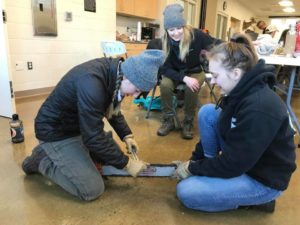 Participants traveled from various regions of the state to attend this course. In fact, I had the honor of assisting with teaching my mother, Susan Topp, a few things as she traveled from Gaylord to attend the training! Some of the participants had no chainsaw experience at all, while others had operated a saw for many years for personal or professional tasks such as cutting firewood, trail maintenance, habitat work, etc. Some participants attended the course to improve their skills and safety while performing tasks on the job.
Participants traveled from various regions of the state to attend this course. In fact, I had the honor of assisting with teaching my mother, Susan Topp, a few things as she traveled from Gaylord to attend the training! Some of the participants had no chainsaw experience at all, while others had operated a saw for many years for personal or professional tasks such as cutting firewood, trail maintenance, habitat work, etc. Some participants attended the course to improve their skills and safety while performing tasks on the job.
Topics covered in the classroom included requirements from the S212 Wildland Fire Chainsaw course which certified each participant to be evaluated for an “A”, “B”, or “C” level sawyer at a later date if they wish. The group learned about basic saw safety, Personal Protective Equipment (PPE), saw anatomy, starting procedure, job hazard analysis, problem-solving, etc. Day 1 was spent at the Hal & Jean Glassen Center and Day 2 was all hands on, starting out with proper saw maintenance while the sun warmed up the field for us. The group then went out into a field site to practice starting techniques, bucking and limbing, open face notches and several felling cuts on stumps in the field.
HERE ARE SOME OF THE KEY ELEMENTS FROM THE COURSE THAT KEEP VOLUNTEERS SAFE AND EFFICIENT IN THE FIELD:
- Safety first!! Do you have required PPE on?
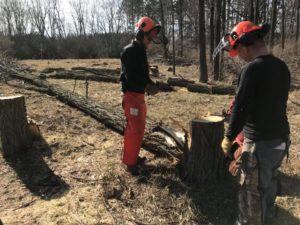 Wearing adequate personal protective equipment (PPE) is the first step to ensure safe chainsaw operation. Every sawyer should wear PPE such as a hardhat with a face shield, eye and ear protection, work gloves, Kevlar chaps, and heavy-duty leather steel-toe boots. You should always have a first aid kit with you and a means of communication such as a cell phone or walkie-talkie. More importantly, have a spotter; it’s nice to alternate when you get tired. Taking care of your saw in the field is important to your safety too, a dull chain is much harder to operate than a sharp chain; be sure to bring a sharpening kit along with fuel and bar oil.
Wearing adequate personal protective equipment (PPE) is the first step to ensure safe chainsaw operation. Every sawyer should wear PPE such as a hardhat with a face shield, eye and ear protection, work gloves, Kevlar chaps, and heavy-duty leather steel-toe boots. You should always have a first aid kit with you and a means of communication such as a cell phone or walkie-talkie. More importantly, have a spotter; it’s nice to alternate when you get tired. Taking care of your saw in the field is important to your safety too, a dull chain is much harder to operate than a sharp chain; be sure to bring a sharpening kit along with fuel and bar oil.
- Chainsaw Operation Tips
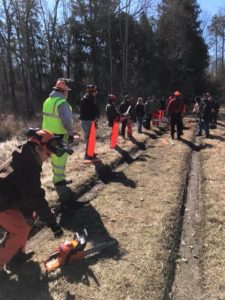 Start your saw up safely with two points of contact rather than attempting a drop-start. Always use both hands when cutting and limbing, making sure to wrap your thumb around the handle and keep the saw below shoulder height. When cutting branches out of your way from the tree before felling, it is best to limb from the top downward. When you’re bucking the trunk after felling, stay on the uphill side of the tree and consider slope, tension and compression, pivot points, and rolling to stay clear of the tree. Always cut the compression side before tension to prevent getting your saw pinched. Also, observe the kerf (the opening or closing angle of the cut you’re making); use wedges to prevent the kerf from closing and to ensure that the tree will be felled in the direction you want it to go.
Start your saw up safely with two points of contact rather than attempting a drop-start. Always use both hands when cutting and limbing, making sure to wrap your thumb around the handle and keep the saw below shoulder height. When cutting branches out of your way from the tree before felling, it is best to limb from the top downward. When you’re bucking the trunk after felling, stay on the uphill side of the tree and consider slope, tension and compression, pivot points, and rolling to stay clear of the tree. Always cut the compression side before tension to prevent getting your saw pinched. Also, observe the kerf (the opening or closing angle of the cut you’re making); use wedges to prevent the kerf from closing and to ensure that the tree will be felled in the direction you want it to go.
- Felling Trees: “Hazards lean towards my escape route which hinges on my cutting plan.”
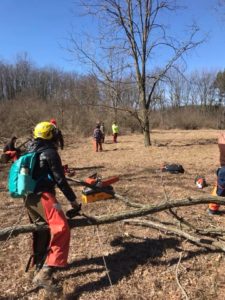 The phrase “Hazards lean towards my escape route which hinges on my cutting plan,” summarizes the process in which to safely fell a tree. Look out for potential hazards such as throwbacks, lodged trees, widow-makers, snags, spring-poles, and terrain. Determine the lean of the tree. Lean has two directions; first is the side lean left or right, and second is forward or back lean. Plan escape routes 45 degrees from back lay to the good side and 45 degrees from the bad side and stand clear at least 15 feet. Always leave a hinge in the tree; this is your only control in felling the tree slowly and precisely where you want it. Have a cutting plan in mind; the most sure felling cut is the open face bore cut-see the full article and diagram of this technique here.
The phrase “Hazards lean towards my escape route which hinges on my cutting plan,” summarizes the process in which to safely fell a tree. Look out for potential hazards such as throwbacks, lodged trees, widow-makers, snags, spring-poles, and terrain. Determine the lean of the tree. Lean has two directions; first is the side lean left or right, and second is forward or back lean. Plan escape routes 45 degrees from back lay to the good side and 45 degrees from the bad side and stand clear at least 15 feet. Always leave a hinge in the tree; this is your only control in felling the tree slowly and precisely where you want it. Have a cutting plan in mind; the most sure felling cut is the open face bore cut-see the full article and diagram of this technique here.
All of these key elements have been implemented in our own safety system with volunteers on wildlife habitat projects. A few participants gained important knowledge even after having prior sawyer experience for many years. Using these felling techniques in my own experience, every tree went where I had planned it to; which is important for my spotter’s safety too! Having a good safety system not only keeps you and your gear safe, it keeps you efficient.
About the Course Partners:
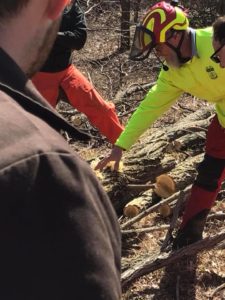 Scott Peterson is with SOS Tree Service: Precision Directional Tree Felling by a Top-Certified Sawyer
Scott Peterson is with SOS Tree Service: Precision Directional Tree Felling by a Top-Certified Sawyer
“When you want a tree removal job done by a nationally certified sawyer, please call me, Scott Peterson, of SOS Tree Service. SOS Tree Service is fully insured to protect your property.” He gave a very generous amount of his time to evaluate 9 participants over the course of the weekend. Scott is nationally certified by the U.S. Forest Service with the highest certification–a Level “C” Trainer. Evaluation included saw handling and starting procedure, communication, and various cutting and felling techniques dependent upon the level.
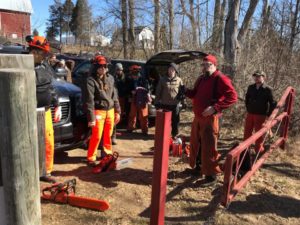 Bill Rushford is COO of the Heavy Equipment Response Coalition. The Coalition is a nonprofit organization that utilizes volunteers to rapidly respond to natural and man-made disasters using owner-operated heavy equipment throughout the United States. They are currently building a database of individuals, organizations, and businesses who own and operate heavy equipment of all types, including chainsaws, and wish to volunteer their equipment with operator to Immediate Response or Recovery efforts in their local area, or nationally. If you’re interested, contact by email to heavyequipmenthelp@gmail.com. There will be local Michigan opportunities to volunteer when the spring storm season comes around!
Bill Rushford is COO of the Heavy Equipment Response Coalition. The Coalition is a nonprofit organization that utilizes volunteers to rapidly respond to natural and man-made disasters using owner-operated heavy equipment throughout the United States. They are currently building a database of individuals, organizations, and businesses who own and operate heavy equipment of all types, including chainsaws, and wish to volunteer their equipment with operator to Immediate Response or Recovery efforts in their local area, or nationally. If you’re interested, contact by email to heavyequipmenthelp@gmail.com. There will be local Michigan opportunities to volunteer when the spring storm season comes around!
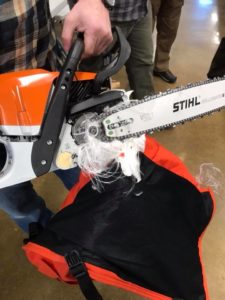 Aaron Smith with Bryan Equipment Sales and Jon with Midwest Power Equipment donated valuable time and resources to make this course even better for the participants. Aaron did a demonstration for the group cutting into a pair of chaps to show the importance of proper PPE. Aaron also provided a great amount of knowledge and resources for Stihl saws and other equipment. Midwest Power Equipment donated 2-cycle engine oil and various sized of chain files and guides.
Aaron Smith with Bryan Equipment Sales and Jon with Midwest Power Equipment donated valuable time and resources to make this course even better for the participants. Aaron did a demonstration for the group cutting into a pair of chaps to show the importance of proper PPE. Aaron also provided a great amount of knowledge and resources for Stihl saws and other equipment. Midwest Power Equipment donated 2-cycle engine oil and various sized of chain files and guides.
Looking to volunteer at a wildlife habitat improvement event with On the Ground? Check out the updated project list here!
MUCC’s On The Ground Program is supported by the Michigan Department of Natural Resources Wildlife Division
